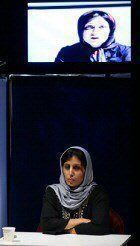Documentary theatre is a notoriously difficult style to present in an engaging and theatrical manner. Mehr Theatre Group's Quartet: A Journey North battles valiantly against the constraints of the form and achieves better success than most similar productions, but it's by no means a flawless piece of theatre.
The text is twice removed from its source material; it's based on a documentary by one of the four performers, Mahin Sadri, itself composed of eyewitness testimony concerning a murder in Iran.
The production draws deeply from the well of documentary filmmaking techniques, resulting in a play composed almost entirely of talking heads against a black background.
The setup certainly has theatrical potential. Four actors sit in the centre of the Pit, facing out towards the audience. A television screen hangs above each one and pull-down blinds hide each actor from three quarters of the audience.
Each actor has a table, a chair, a glass of water, a tissue and a remote control for the camcorder aimed at them. The camcorders relay live images of whoever is currently speaking to the three quarters of the audience that can't see them, via the hanging televisions.
The idea, presumably, is that no one person can ever see the full picture when it comes to murder. The cameras are focused in close on the actors' faces, so each quarter of the audience is denied a good deal of gesture and body language from three out of four actors.
Not to mention the fact that the screens aren't always showing the same picture. With a bit of unsubtle craning around, I managed to confirm that at one point, when my actor was speaking and my screen was showing a drive around the mountain roads leading to Tehran, the audience to my right were only seeing my actor's face.
The technical arrangement and the intent behind it are certainly worthy of appreciation. But for three quarters of the play you're forced to watch the screen because you can't see the speaker directly, and even when you can see the speaker you still have to watch the screen for the surtitles - unless, of course, you speak Persian.
So monolingual Brits are forced to watch the screen for the entire play ... which means that for them the only major difference between this play and a screening of Sadri's documentary, presumably, is that the testimony is live.
The use of close-ups, a directorial technique normally denied to the theatre, does partially excuse the totally static staging. The actors aren't really doing anything, but we're treated to every detail of their facial expressions: conspiratorial sidelong glances, smirks and silent tears that might not be obvious without the big screens.
And the text is engaging, taking us procedurally through every step leading up to the two murders in such detail that it's impossible to forget these are true accounts of real events.
The flaw lies in simultaneous over- and under-use of the different visual media in use. There's so much focus on the screens that Quartet almost doesn't feel like a piece of theatre at all; yet they're only used to relay what's happening on stage, bracketed by some aimlessly atmospheric stock footage of traffic jams and seasons passing.
If Mehr intend the screens to be the star of the show, surely they could do more with them?
Until December 6th, 2008
